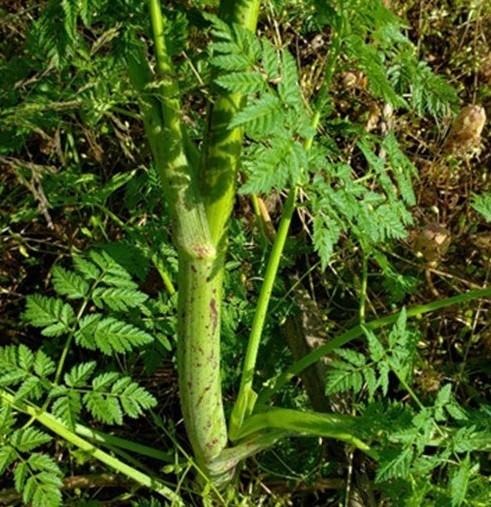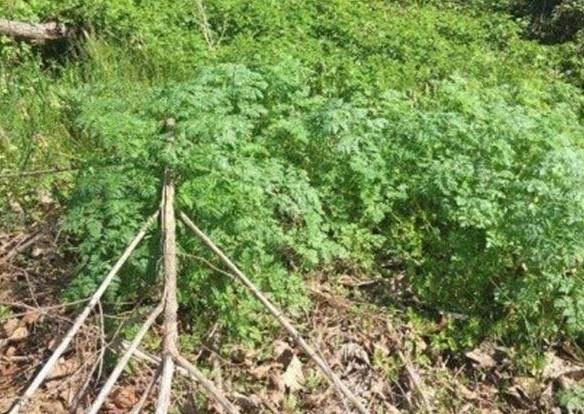By Dwight Lingenfelter and Jeffrey S Graybill
Plant family: Poison hemlock (Conium maculatum) is in the carrot or Umbelliferae family and the leaves and foliage resemble carrot and parsley.
Look-alikes: Wild carrot (also called Queen Anne's lace), wild parsnip, spotted waterhemlock, and purple-stemmed angelica can sometimes be confused with poison hemlock because they are in the same family and have some similar features. Cow parsnip and giant hogweed are also in the same family; however, they are much larger in stature and should not be easily mistaken with poison hemlock.
Lifecycle: Poison hemlock germinates from seed and is a biennial plant with a basal rosette of leaves during its first year. Once it overwinters, in late April/early May, it bolts into an erect branched plant producing prominent white flowers in an umbel generally in June and July. It sets and drops seeds soon after. This weed only reproduces by seed and its taproot dies as the main plant desiccates.

Image of poison hemlock during vegetative stage. Image Credit: D. Lingenfelter, Penn State Weed Science
Characteristics: In addition to its fern-like, glossy green, lacy leaves, the plant has a hairless, hollow main steam with purple blotches/spots which branches. Its large flower-structures are composed of many smaller white flowers. Plants typically grow 2 to 6 feet tall and have a parsnip-like odor when the leaves are crushed.

Image of poison hemlock at flowering. Image Credit: D. Lingenfelter, Penn State Weed Science.
Poisonous traits: The sap can cause dermatitis (skin irritation) on some people. So be sure to wear protective clothing and gloves when handling the plant or when weed-whacking. It is poisonous when ingested by humans and livestock. The plant contains several closely related pyridine alkaloids with the main one being coniine, a colorless, volatile, and strongly alkaline oil. All parts of the plant are poisonous, and some studies have shown toxicosis at 0.25% fresh wt. (of the animal’s weight) for horses and 0.5% for cattle. That would be 2.5 to 5 lb. of material per 1000 lb. animal. Mature seeds are the most poisonous. Significant poisoning can result in muscle paralysis and suffocation.

Poison Hemlock, early April, central PA. Note dead seed stalk from previous year. Image Credit: J. Graybill, Penn State Extension.
Habitat: It grows along roadsides and in no-till fields, fencerows, pastures, fallow area, and waterways.

Poison hemlock growing along a roadside in Lancaster County. Image Credit: J. Graybill, Penn State Extension.
Control: Individual plants can be easily dig out with a shovel. Larger infestations can be cut with a mower or string trimmer or may require the use of a herbicide. Several herbicides are effective for control. Herbicide applications are most effective when they are sprayed in the fall when poison hemlock is in the rosette stage or before it bolts in the spring. Effective herbicides include 2,4-D + dicamba, Crossbow (2,4-D+triclopyr), or glyphosate as a spot treatment.
Other interesting facts: Poison hemlock is native to Europe, northern Africa, and western Asia and was introduced to North America as an ornamental garden plant. In the annals of history, it was noted that the Greek philosopher Socrates chose to drink poison hemlock tea for his execution.
Source : psu.edu